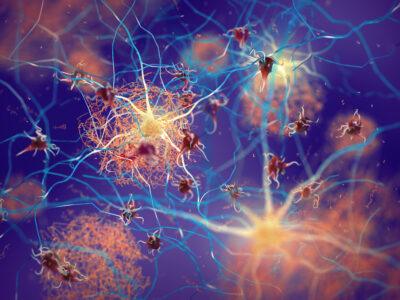Lion’s Mane Mushroom and Alzheimer’s Disease: A Beacon of Hope in Natural Neuroprotection

With the escalating global burden of Alzheimer’s disease, the quest for effective therapeutic strategies has reached a critical juncture. Alzheimer’s, the most prevalent progressive neurodegenerative disease, is characterized by cognitive decline, memory loss, and behavioral changes that severely impair quality of life.
Despite decades of research, current treatment options for AD offer only symptomatic relief and demonstrate limited efficacy. However, amidst this challenge, a unique ray of hope emerges in the form of Lion’s Mane Mushroom, a natural compound with neuroprotective properties that is gaining increasing attention in the scientific community.
Lion’s mane mushroom has long been used in traditional East Asian medicine for its cognitive and health-promoting properties. However, its potential remains largely untapped in Western medical practice. Recent scientific investigations suggest that this mushroom contains unique bioactive compounds capable of influencing critical neurobiological processes implicated in Alzheimer’s, offering a promising new frontier for AD prevention and management.
A Systematic Review of Hericium Erinaceus in Alzheimer’s Research
A systematic review conducted by Cornford, Liu, and Charnley (2024) from Liverpool Hope University aims to assess the therapeutic potential of Hericium erinaceus in the context of Alzheimer’s disease.
The researchers employed a rigorous review process, adhering to PRISMA guidelines and Cochrane RoB2 tools for quality assessment, to identify and evaluate studies that examined the relationship between Hericium erinaceus intake and AD-related outcomes.
The review analyzed 16 studies, comprising three human clinical trials and thirteen animal studies. The inclusion criteria focused on clinical trials involving adults over 30 years old with mild cognitive impairment, probable AD, or memory deficits, as well as animal studies that directly examined interventions affecting AD-related mechanisms.
Studies with confounding interventions or involving other neurological disorders were excluded, ensuring a high degree of relevance and focus on the potential of Hericium erinaceus in AD.

Studies reviewed demonstrate that Hericium erinaceus intake significantly reduces the accumulation of β-amyloid plaques, which are a hallmark of Alzheimer’s disease.
Neuroprotective Mechanisms of Hericium Erinaceus
One of the most significant findings highlighted in the review is the role of Hericium erinaceus in promoting neurotrophic and neuroprotective pathways. A central compound identified in the mushroom is Erinacine A, which has been shown to stimulate the production of nerve growth factor (NGF)—a crucial protein for the growth, maintenance, and survival of neurons (Feng et al., 2019). NGF deficits are well-established features of Alzheimer’s pathology, contributing to the degeneration of cholinergic neurons in the brain.
The studies reviewed also demonstrate that Hericium erinaceus intake significantly reduces the accumulation of β-amyloid plaques, which are a hallmark of Alzheimer’s disease. These plaques disrupt neural communication and trigger inflammatory responses that exacerbate neurodegeneration. The ability of HE to mitigate β-amyloid aggregation suggests that it may directly address one of the root pathological processes in AD.
Impact on Cognitive Function and Biomarkers
Clinical and preclinical trials analyzed in the review provide compelling evidence of cognitive improvements associated with Hericium erinaceus supplementation. Human participants with mild cognitive impairment or AD-like symptoms who received HE supplementation showed statistically significant improvements in memory and cognitive function compared to control groups (p
In animal models, Hericium erinaceus administration resulted in greatly marked behavioral improvements, suggesting enhanced memory and learning capabilities. Biochemical assessments further revealed that HE treatment restored acetylcholine levels and reduced oxidative stress, both critical factors in maintaining neural health and cognitive performance.
Histological evaluations of brain tissue from AD-induced rodents treated with HE displayed reduced neuroinflammation, including decreased activation of microglia and astrocytes and less neuronal loss compared to untreated controls.
Future Directions and Call for Clinical Trials
Despite the promising results from animal models and preliminary human studies, the review underscores the urgent need for more extensive and more comprehensive clinical trials to establish Hericium erinaceus as a reliable therapeutic option for AD. Currently, human trials remain limited in scale. (No money to made by big-pharma with Lion’s Mane since it’s widely available.)
While they show positive trends, broader population studies are essential to confirm safety, efficacy, dosing, and long-term impacts. This emphasis on the need for further research highlights the potential of Hericium erinaceus and encourages the scientific community to invest in more robust clinical trials.
Further, understanding the precise molecular mechanisms by which erinacine A and other Hericium erinaceus compounds influence neurodegenerative processes will be vital. This understanding could lead to the development of targeted therapies or refined natural supplements designed specifically to combat Alzheimer’s pathology. By stressing the importance of this research, the article highlights the potential for future developments in AD treatment.
A Natural Path Forward in Alzheimer’s Therapy?
In conclusion, Hericium erinaceus emerges from this systematic review as a highly promising candidate for the prevention and delayed progression of Alzheimer’s disease. Its demonstrated abilities to promote nerve growth, reduce amyloid plaque buildup, enhance cholinergic transmission, and modulate neuroinflammation make it a unique natural agent worthy of serious consideration in future AD therapies.
As the global population ages and Alzheimer’s cases rise, harnessing the power of such natural compounds could represent a crucial step toward more effective and holistic approaches to neurodegenerative diseases.
However, realizing this potential requires robust investment in clinical research and a commitment to integrating natural compounds into mainstream neurological care. As Cornford and colleagues (2024) highlight, with the growing recognition of HE’s benefits, the scientific community is now tasked with building a solid foundation of evidence to support its inclusion in the therapeutic arsenal against Alzheimer’s disease.
References:
Masters C, Bateman R, Blennow K, Rowe C, Sperling R, Cummings J. Nature Reviews. [Online]; 2015. Available: https://www.nature.com/articles/nrdp201556
Tsai-Teng T, Chin-Chu C, Li-Ya L, Wan-Ping C, Chung-Kuang L, Chien-Chang S, et al. NCBI. [Online]; 2016. Available: https://www.ncbi.nlm.nih.gov/pmc/articles/PMC4924315/
Feng L, Cheah IKM, Ng MM, Chan SM, Lim SL, Mahendran R. IOS Press. [Online]; 2019. Available: https://content.iospress.com/articles/journal-of-alzheimers-disease/jad180959
Cornford N, Liu S, Charnley M. “Hericium erinaceus: A possible future therapeutic treatment for the prevention and delayed progression of Alzheimer’s disease? – A Systematic Review.” Proceedings of the Nutrition Society (2024), 83 (OCE4), E273. doi:10.1017/S0029665124005111
The post Lion’s Mane Mushroom and Alzheimer’s Disease: A Beacon of Hope in Natural Neuroprotection appeared first on Off The Grid News.
Source: https://www.offthegridnews.com/alternative-health/lions-mane-mushroom-and-alzheimers-disease-a-beacon-of-hope-in-natural-neuroprotection/





































(28).jpg)
(29).jpg)
.jpg)





